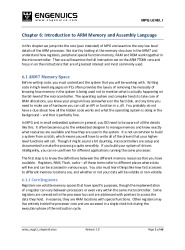Introduction to ARM Memory and Assembly Language
The ARM (Acorn RISC - Reduced Instruction Set Computer - Machine) is designed by ARM Ltd (Advanced RISC Machines), a former subsidiary of the late Acorn company, and built by VLSI Technology or sometimes Gec Plessey, Sharp or TI.
Acorn was an English company which built in the early 1980s a microphone called BBC, of ??8-bit architecture, very widespread in the island. Since 1983, it has embarked on the implantation of a microprocessor RISC (based on the Berkeley model) on silicon. At the time, fashion was the 8/16 bit Complex Instruction Set Computer (CISC) processor and Intel was selling its 8086. The goal of Acorn was to design a powerful, low-power processor. ARM was born of the success of this company, in November 1990.
Acorn computers have been widely used in Commonwealth countries as well as in Germany and are mostly used in education. The French market unfortunately did not obey the enthusiasm that had aroused the appearance of the first computer RISC Acorn, the Archimedes, following the mass market of the time and remaining apathetic as usual.
My goal in this page is to introduce you to the wonderful possibilities that arise from the research of Acorn (then ARM) in the field of processors. A lot of the Acorn shares were held by the multinational Olivetti, but that does not matter. Acorn was one of the last companies to offer a platform with a non-MS-DOS-compatible OS that survived the IBM PC surge. Being a former Atarist and always amateur of these superb machines, I want to defend here my new loves of sillicium.
Table of contents
- ARM7 Memory Space
- Core Registers
- ARM state registers
- Bit assignments in the CPSR
- Peripheral Registers
- Special Function Memory
- General Purpose RAM
- Flash memory
- The ARM7TDMI Instruction set
- Writing Assembly Code
- Assembly Language Syntax
- The Barrel Shifter
- Constant Values
- Simple Data Processing Instructions
- Load and Store Instructions
- Single Load and Store Instructions
- Branch Instructions
| Size : | 771.92 Kb |
| File type : | |
| Downloads: | 464 |
| Created: | 2017-01-01 |
Warning: Trying to access array offset on false in /home/tutovnfz/public_html/article.php on line 233
Others Memory Tutorials
DRAM: Architectures, Interfaces, and Systems
ROM, EPROM, and EEPROM pdf tutorial
Others related eBooks about Introduction to ARM Memory and Assembly Language
Fundamentals of computer architectureDownload tutorial in PDF about the fundamentals of computer architecture ,it's a free training document under 290 pages for experienced users by Mostafa Abd-El-Barr and Hesham El-Rewini....
Spring Framework Notes for ProfessionalsDownload free course Spring Framework Notes for Professionals, pdf file on 67 pages by Stack Overflow Community....
Basic Computer UsageYou will with this pdf tutorial the basics of computer sciences, installing software, running commandes and using files....
Computer Fundamentals courseWith this course, you will learn how a computer works, it introduces you to assembly-level programming. You will be able to write a simple assembly language program. At the end of the tutorial, you’ll be able to understand the different types of information which may be stored in a computer memory...
ROM, EPROM, and EEPROM pdf tutorialDownload free pdf tutorial about ROM, EPROM, and EEPROM, training course intended to beginners....
How to Think Like a Computer ScientistDownload free course How to Think Like a Computer Scientist, pdf file on 280 pages by Allen Downey, Jeffrey Elkner, Chris Meyers....
Computer basics for beginnersA basic computer tutorial is a step-by-step guide that is designed to provide beginners with an understanding of the fundamental components and functionalities of a computer....
Computer Design Systems and Logical OrganizationThis tutorial gives a complete understanding on Computer Design Systems and Logical Organization ,basic computer overview and advanced architecture....
Basic Computer Hardware TutorialDownload Basic Computer Hardware Tutorial, training document in pdf intended to beginners....
Analysis for Computer ScientistsDownload free course Analysis for Computer Scientists, pdf file on 372 pages by by Michael Oberguggenberger, Alexander Ostermann....
